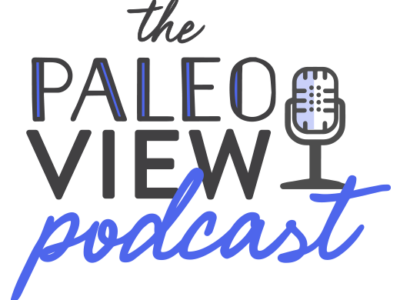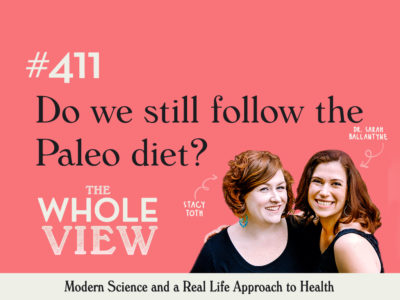In this episode, Stacy and Sarah invite Mickey Trescott of Autoimmune Paleo, author of The Autoimmune Paleo Cookbook, to discuss the release of her new cookbook and to help address a series of questions that relate to autoimmune conditions and how to handle fruit consumption, the reintroduction of foods, ideal vitamin D levels and more.
Listen in iTunes
or download and listen by clicking the PodBean player below
We’re now on Stitcher!
If you enjoy the show, please review it in iTunes!
The Paleo View (TPV), Episode 40: Practical Autoimmune Protocol
- 0:00 – Introduction
- 1:19 – News & Views
- The Paleo Parents family has been busy doing fun things and Stacy is feeling tired, but as a result of good outdoor activities and fun with the boys
- Sarah turned in part two of her book this last week after spending a bit of time making final adjustments and edits
- Part 3 is the cookbook and Sarah needs to finalize and type the recipes, but isn’t feeling very motivated
- Sarah is having a hard time switching her brain out of science mode to develop the cookbook portion of The Paleo Approach, but has been giving herself some slack to recharge a bit since over 100 recipes are ready
- Sarah has the relief of being done without actually being done and is in a tired fog
- This week’s guest is Mickey Trescott, who is the blogger behind autoimmune-Paleo.com and is a personal chef with amazing recipes to offer
- Mickey has both celiac and Hashimoto’s disease and follows the autoimmune protocol
- She just released an e-book that is called The Autoimmune Paleo Cookbook, which has 110 autoimmune protocol friendly recipes that cover the whole gamut of food needs
- Stacy was most impressed by the quality of the food photos and “soup to nuts” i.e. the level of information behind the ‘why’
- Stacy feels that her first 90 days on AIP wouldn’t have felt so overwhelming and restricting had she had The Autoimmune Paleo Cookbook
- Thanks to supportive friends, Mickey was able to pull together the book at the quality level that she expected
- Recently Stacy requested that Matt make Julia Child’s Chicken Live Mousse and Stacy is in love with the taste of this dish, and her joints and skin feel and look better after eating this dish with consistency for a week
- Six months ago if Stacy would have had something with dairy fat in it, she feels like she would have had a major problem, and she is wondering if the livers are counterbalancing the impact of dairy fat or if her hard work to help repair her system is the result of her tolerance
- Sarah notes that liver is the most nutrient dense food available and the ratio of amino acids is higher in organ meat, which is required for skin and connective tissue – the diary fat is helpful to bone, joint and connective tissue health as well
- Sarah has been eating a homemade organ meat sausage everyday and is feeling amazing – the bison liver in the recipe is in particular the rockstar of the sausage
- Stacy is surprised that she is handling the dairy fat
- Sarah suspects that the raw dairy fat, which has some naturally occurring enzymes, is helping and that Stacy’s gut health is in a calm state and not acting overwhelmed by each exposure to possibly problematic foods
- Stacy knows she is not totally healed, but is surprised and proud to make this discovery regarding her tolerance towards dairy fat – there is a light at the end of the tunnel folks!
- Sarah recently found a local farmer with soy and wheat free eggs and she has been able to eat the eggs without any reactions – is very excited, but is still being very cautious
- Mickey had a similar reaction to Stacy where she made a shocking discovery about her tolerance towards dairy fat – and she thought she would be on AIP forever, but is learning that her system is healing and may be able to tolerate a little bit here and there
- 29:41 – Science with Sarah: is fruit allowed on the autoimmune protocol?
- Fruit is absolutely allowed on AIP, there are no restrictions on the types you can eat, and fruit is very vitamin, mineral and nutrient dense
- When you look at the glycemic load of fruit, all fruits are either low or moderate, with the exception of dried fruit
- If you are sticking to low and moderate glycemic foods, you have to eat a lot of fruit to receive a high glycemic load
- The concern with fruit is making sure that your blood sugar is well regulated and not over-consuming fructose
- Where as glucose is easily converted to energy, high levels of fructose can lead to high blood triglycerides
- In a Paleo diet we don’t tend to consume too much fructose, depending on how many pieces of fruit you are consuming
- Sarah’s recommendation is to make sure that your blood sugar levels are well regulated and make sure that your fructose is between 10 and 20 grams a day
- Over avoiding fruit can be strenuous on the thyroid because you do want to stimulate the production of some insulin
- Stacy notes that if you are eating a high fat, low carb, moderate protein diet, it may not be enough for the thyroid conversion
- Both high and low carb diets are strenuous on the thyroid
- Sarah does not recommend a ketogenic diet with autoimmune disease because the research shows that it makes it worse
- Stacy recently reintroduced dates without guilt and found this to be funny because dates are good for you
- Both Stacy and Sarah completed a 21 Day Sugar Detox and did so not to necessarily limit fruit, but to limit sweeteners
- Everyone needs to find what works for them, but Stacy feels that she does well with a moderate carb intake from fruits and starchy vegetables
- Mickey tried a ketogenic diet and didn’t feel good, it is a little too intense and caused some thyroid issues
- Include fruit, but don’t go crazy – enjoy it and don’t over-complicate this healthy choice
-

- 42:35 – Q&A
- Michelle: Tips on managing Psoriasis through diet: can I eat eggs? Can I take raw hemp powder or wheat grass juice? Need to avoid weight-loss, what can I eat? What is the ideal range for my vitamin d3 levels? Do you know of any Psoriasis cookbooks?
- Egg whites contains lysozyme, which is good at crossing the gut barrier and it forms monster molecules with random things in the gut, then transporting this monster into the gut
- People with autoimmune diseases are already dealing with a leaky gut and an over-reactive immune system, so dealing with an extra transporter is not helpful
- The effect is relatively small in those with healthy guts
- Egg yolk is a common food allergy and that is why it is omitted, but it is also the food that Sarah recommends to reintroduce first
- Moving from gluten free to AIP can be overwhelming, so testing a purely Paleo diet first may be a manageable first step
- However, some may be better off jumping right into AIP if that is the kind of change that you respond well to
- Know your personality and pick a path that is going to lead to success for you
- Yes avoid hemp seed, wheat grass juice and algae powders
- Avoid hemp because it is a seed
- Avoid wheat grass juice because there is a toxic protein present and is good at increasing gut permeability
- Avoid algae because it has properties that stimulate the immune system – if you have a leaky gut, you are adding to the toxins leaking into your body
- Being underweight with autoimmune condition is typically a sign of severe gut damage, so do all the things that are typically discussed on this show for healing the gut (time outdoors, sleep, stress management, bone broth, organ meat, digestive support supplements)
- Work with your doctor to perhaps be tested for micro-nutrient deficiencies for targeted supplementation
- Make sure that when you eat you eat nutrient dense foods with both animal and plant based foods
- Try to eat every three hours and once your gut has healed you can try every four to five hours
- Sleep sleep sleep and mange your stress!
- Yes, increase your vitamin D3, 60 to 70 is a really good target
- Vitamin D rich foods are pastured/grass-fed meats, wild fish, wild mushrooms
- Also spend time outdoors to increase vitamin D
- Retest frequently because you don’t want to overshoot your target
- Make sure that you are also using high quality fats to cook with: lard, tallow, bacon fat, etc.
- When you get to a healthy place in your body, you are able to better absorb the vitamin D, and may need less supplementation
- Additional resources: Mickey’s book, Stacy’s AIP Pinterest board, Sarah’s book, Sarah’s AIP Pinterest board, Sarah’s AIP recipe page
- The Paleo Approach features recipes completely different from The Autoimmune Protocol cookbook, so get both because you will have a great resource of over 230 recipes
- (1:08:30) Debra: My daughter is having trouble swallowing, can you suggest some AIP friendly foods that she may be able to tolerate (must avoid fruit, cocoa, nuts, and fermented products)?
- Mickey suggests starting with bone broth and then make long, slow braises of well cooked meats and throw it in a blender with bone broth
- Try to sneak in some pate or liver that you could dissolve into some broth
- Pureed vegetables like greens, sweet potatoes and other root vegetables are a great choice
- Make sure she gets enough protein
- If she is making progress add egg yolks that are carefully separated from the whites
- Sarah notes that some have a better time with thicker liquids, and you could thicken it with pureed vegetables, arrowroot powder, and kudzu starch
- You could even melt in coconut oil or lard to increase the fat content
- (1:15:22) Karen: What signs should I look for that my body is ready for me to reintroduce foods that were eliminated? Since I am avoiding dairy, should I avoid taking the fermented cod liver/butter blend?
-
If you aren’t seeing improvements yet, it is too early to start reintroduction, especially with chocolate and coffee
- You could play with adding adding grass-fed dairy fats and egg yolks
- Sarah suggests tinkering with an increase in carb intake and focus on nutrient dense foods, organ meat, etc.
- Symptoms to look for: any symptoms of your disease returning or worsening, stomach aches, changes in bowel movement consistency, heartburn, nausea, gas, bloating, undigested or partially digested particles in the stool, dips in energy, feeling more energetic before bed, strong food cravings, trouble sleeping, having to pee more than once a night, headaches, dizziness, feeling light headed, increase in mucous production, itchy eyes or mouth, swelling anywhere, sneezing, aches and pains in the muscles, joins, ligaments, any changes in skin, dry hair, brittle fingernails, mood issues
- Introduce foods slowly and give some time in between introductions
- If you aren’t sure don’t continue eating the food, and move on and try again in a few weeks
- Introduce one food at a time, every three to seven days, eat it a couple of time on one day and don’t eat it again, and then look for those signs
- Stacy use to take the butter blend and found that it was causing some skin problems, so switched to just taking the fermented cod liver oil
- Better to air on the side of caution and stick to fermented cod liver oil
- Mickey suggests that this would be a good time to return to your doctor for a full thyroid test to especially check on T3 levels
- Some autoimmune diseases may require medication to support organ function
- Its not just about the diet – being able to manage stress, get proper sleep and explore the medical options that will work best for you is key to success
-
- Thanks to Mickey for joining The Paleo View for episode 40 and for creating such a powerful tool with The Autoimmune Paleo Cookbook
- Michelle: Tips on managing Psoriasis through diet: can I eat eggs? Can I take raw hemp powder or wheat grass juice? Need to avoid weight-loss, what can I eat? What is the ideal range for my vitamin d3 levels? Do you know of any Psoriasis cookbooks?
- 1:31:04 – Outro









